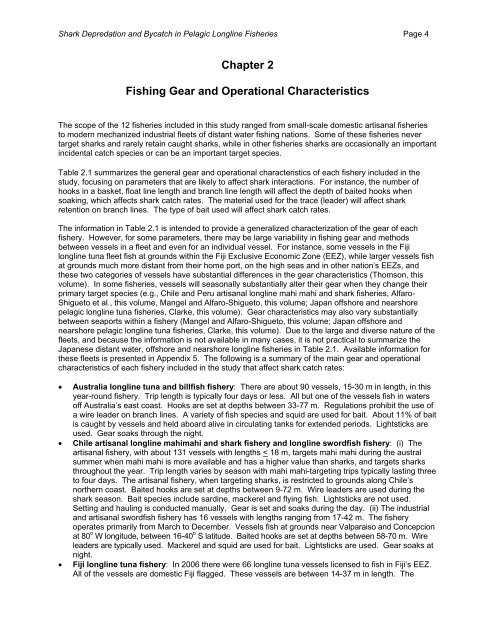Shark Depredation and Unwanted Bycatch in ... - ProDelphinus
Shark Depredation and Unwanted Bycatch in ... - ProDelphinus
Shark Depredation and Unwanted Bycatch in ... - ProDelphinus
Create successful ePaper yourself
Turn your PDF publications into a flip-book with our unique Google optimized e-Paper software.
<strong>Shark</strong> <strong>Depredation</strong> <strong>and</strong> <strong>Bycatch</strong> <strong>in</strong> Pelagic Longl<strong>in</strong>e Fisheries Page 4<br />
Chapter 2<br />
Fish<strong>in</strong>g Gear <strong>and</strong> Operational Characteristics<br />
The scope of the 12 fisheries <strong>in</strong>cluded <strong>in</strong> this study ranged from small-scale domestic artisanal fisheries<br />
to modern mechanized <strong>in</strong>dustrial fleets of distant water fish<strong>in</strong>g nations. Some of these fisheries never<br />
target sharks <strong>and</strong> rarely reta<strong>in</strong> caught sharks, while <strong>in</strong> other fisheries sharks are occasionally an important<br />
<strong>in</strong>cidental catch species or can be an important target species.<br />
Table 2.1 summarizes the general gear <strong>and</strong> operational characteristics of each fishery <strong>in</strong>cluded <strong>in</strong> the<br />
study, focus<strong>in</strong>g on parameters that are likely to affect shark <strong>in</strong>teractions. For <strong>in</strong>stance, the number of<br />
hooks <strong>in</strong> a basket, float l<strong>in</strong>e length <strong>and</strong> branch l<strong>in</strong>e length will affect the depth of baited hooks when<br />
soak<strong>in</strong>g, which affects shark catch rates. The material used for the trace (leader) will affect shark<br />
retention on branch l<strong>in</strong>es. The type of bait used will affect shark catch rates.<br />
The <strong>in</strong>formation <strong>in</strong> Table 2.1 is <strong>in</strong>tended to provide a generalized characterization of the gear of each<br />
fishery. However, for some parameters, there may be large variability <strong>in</strong> fish<strong>in</strong>g gear <strong>and</strong> methods<br />
between vessels <strong>in</strong> a fleet <strong>and</strong> even for an <strong>in</strong>dividual vessel. For <strong>in</strong>stance, some vessels <strong>in</strong> the Fiji<br />
longl<strong>in</strong>e tuna fleet fish at grounds with<strong>in</strong> the Fiji Exclusive Economic Zone (EEZ), while larger vessels fish<br />
at grounds much more distant from their home port, on the high seas <strong>and</strong> <strong>in</strong> other nation’s EEZs, <strong>and</strong><br />
these two categories of vessels have substantial differences <strong>in</strong> the gear characteristics (Thomson, this<br />
volume). In some fisheries, vessels will seasonally substantially alter their gear when they change their<br />
primary target species (e.g., Chile <strong>and</strong> Peru artisanal longl<strong>in</strong>e mahi mahi <strong>and</strong> shark fisheries, Alfaro-<br />
Shigueto et al., this volume, Mangel <strong>and</strong> Alfaro-Shigueto, this volume; Japan offshore <strong>and</strong> nearshore<br />
pelagic longl<strong>in</strong>e tuna fisheries, Clarke, this volume). Gear characteristics may also vary substantially<br />
between seaports with<strong>in</strong> a fishery (Mangel <strong>and</strong> Alfaro-Shigueto, this volume; Japan offshore <strong>and</strong><br />
nearshore pelagic longl<strong>in</strong>e tuna fisheries, Clarke, this volume). Due to the large <strong>and</strong> diverse nature of the<br />
fleets, <strong>and</strong> because the <strong>in</strong>formation is not available <strong>in</strong> many cases, it is not practical to summarize the<br />
Japanese distant water, offshore <strong>and</strong> nearshore longl<strong>in</strong>e fisheries <strong>in</strong> Table 2.1. Available <strong>in</strong>formation for<br />
these fleets is presented <strong>in</strong> Appendix 5. The follow<strong>in</strong>g is a summary of the ma<strong>in</strong> gear <strong>and</strong> operational<br />
characteristics of each fishery <strong>in</strong>cluded <strong>in</strong> the study that affect shark catch rates:<br />
• Australia longl<strong>in</strong>e tuna <strong>and</strong> billfish fishery: There are about 90 vessels, 15-30 m <strong>in</strong> length, <strong>in</strong> this<br />
year-round fishery. Trip length is typically four days or less. All but one of the vessels fish <strong>in</strong> waters<br />
off Australia’s east coast. Hooks are set at depths between 33-77 m. Regulations prohibit the use of<br />
a wire leader on branch l<strong>in</strong>es. A variety of fish species <strong>and</strong> squid are used for bait. About 11% of bait<br />
is caught by vessels <strong>and</strong> held aboard alive <strong>in</strong> circulat<strong>in</strong>g tanks for extended periods. Lightsticks are<br />
used. Gear soaks through the night.<br />
• Chile artisanal longl<strong>in</strong>e mahimahi <strong>and</strong> shark fishery <strong>and</strong> longl<strong>in</strong>e swordfish fishery: (i) The<br />
artisanal fishery, with about 131 vessels with lengths < 18 m, targets mahi mahi dur<strong>in</strong>g the austral<br />
summer when mahi mahi is more available <strong>and</strong> has a higher value than sharks, <strong>and</strong> targets sharks<br />
throughout the year. Trip length varies by season with mahi mahi-target<strong>in</strong>g trips typically last<strong>in</strong>g three<br />
to four days. The artisanal fishery, when target<strong>in</strong>g sharks, is restricted to grounds along Chile’s<br />
northern coast. Baited hooks are set at depths between 9-72 m. Wire leaders are used dur<strong>in</strong>g the<br />
shark season. Bait species <strong>in</strong>clude sard<strong>in</strong>e, mackerel <strong>and</strong> fly<strong>in</strong>g fish. Lightsticks are not used.<br />
Sett<strong>in</strong>g <strong>and</strong> haul<strong>in</strong>g is conducted manually. Gear is set <strong>and</strong> soaks dur<strong>in</strong>g the day. (ii) The <strong>in</strong>dustrial<br />
<strong>and</strong> artisanal swordfish fishery has 16 vessels with lengths rang<strong>in</strong>g from 17-42 m. The fishery<br />
operates primarily from March to December. Vessels fish at grounds near Valparaiso <strong>and</strong> Concepcion<br />
at 80 o W longitude, between 16-40 o S latitude. Baited hooks are set at depths between 58-70 m. Wire<br />
leaders are typically used. Mackerel <strong>and</strong> squid are used for bait. Lightsticks are used. Gear soaks at<br />
night.<br />
• Fiji longl<strong>in</strong>e tuna fishery: In 2006 there were 66 longl<strong>in</strong>e tuna vessels licensed to fish <strong>in</strong> Fiji’s EEZ.<br />
All of the vessels are domestic Fiji flagged. These vessels are between 14-37 m <strong>in</strong> length. The

















